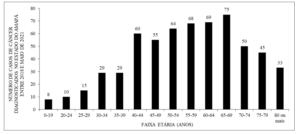ORIGINAL ARTICLE
COSTA, Ana Beatriz Barbosa da [1], MORAIS, Elton Santos Guedes de [2], PALMA, Mariza Brandão [3], SOARES, Anísio Francisco [4]
COSTA, Ana Beatriz Barbosa da. et al. Knowledge about penile cancer in a school in Recife/PE: a qualitative descriptive study. Revista Científica Multidisciplinar Núcleo do Conhecimento. Year. 08, Ed. 02, Vol. 01, pp. 160-175. February 2023. ISSN: 2448-0959, Access link: https://www.nucleodoconhecimento.com.br/health/penile-cancer, DOI: 10.327449/nucleodoconhecimento.com.br/health/penile-cancer
ABSTRACT
According to the World Health Organization, adolescence is characterized by biological, social and psychological transitions, which occur from 10 to 19 years of age. The Child and Adolescent Statute considers adolescents to be between 12 and 18 years old. Sexual behavior is characterized by curiosity and the discovery of pleasure. In this period of discovery, adolescents are faced with various sociocultural taboos that often prevent them from not only preventing the diseases they are susceptible to, but also from seeking treatment when the disease takes hold. Penile cancer accounts for approximately 2.1% of all tumors in men in Brazil, with a higher incidence in the North and Northeast regions. This study was carried out with the objective of evaluating the knowledge of students from the High School Reference School Professor Cândido Duarte, located in the city of Recife/PE. In the case of a descriptive quantitative study, a semi-structured questionnaire on penile cancer, symptoms, risk factors and prevention was applied, with the participation of 42 students. As for symptoms, reddish wounds, swelling, white spots and secretions with a strong odor, were pointed out by 67.4% of respondents. Regarding the main risk factors, sexual intercourse without using a condom, lack of information, accumulation of smegma and phimosis, were mentioned by 86% of the students. 48% of respondents cited the use of condoms during sexual intercourse as a preventive measure. The students demonstrated reasonable knowledge about sex education, however those referring to specific aspects of penile cancer were not satisfactory. Schools, being places frequented by adolescents and also disseminators of knowledge, can also act in the prevention of penile cancer since this, through the adoption of simple measures, can have its rates reduced considerably.
Keywords: Adolescents, Sexually Transmitted Diseases, Teaching, Health, Sexuality.
INTRODUCTION
Adolescence is characterized by intense biological, social and psychic transformations and, according to the World Health Organization – WHO (1965) and the Ministry of Health – MS[5] (BRASIL, 2014), it is a period from 10 to 19 years old. The Child and Adolescent Statute – ECA[6] (BRASIL, 1990), with Law n. 8,069, of July 13, 1990, considers children, people up to 12 years old and adolescents between 12 and 18 years old. Regardless of the age group in which it is included, the term adolescence refers to the stage of life between childhood and adulthood, marked by a complex process of biopsychosocial growth and development, where the individual goes through the transition from childhood to adulthood the adult phase, increasingly exploring their sexuality, which makes them more vulnerable, especially to Sexually Transmitted Infections (STIs) (GENZ et al., 2017).
At this stage of life, efficient information is needed that can help adolescents with regard to sexual activities, especially when they develop behaviors that can pose health risks. In this context, sexuality is characterized by curiosity and the discovery of pleasure, which takes shape through the occurrence of the masturbatory act and the beginning of sexual activity (DOMINGOS; SANTANA and ZANATTA, 2021). The awareness of adolescents during this period of discovery collides with several sociocultural taboos, which often prevent prevention against the diseases to which they are vulnerable and hinder effective reactions regarding their presence (CRUZ et al., 2019). In this sense, it is imperative that prevention goes beyond information on the use of condoms and vaccines, encompassing broader knowledge, always considering that the earlier they are acquired, the better the results will be.
In developed countries, such as the United States and some others in Europe, penile carcinoma is a rare neoplasm that affects approximately 1/100,000 men. On the other hand, a high incidence is observed in developing countries. In some regions of Asia, Africa and South America, this disease represents about 10 to 20% of male urogenital tumors, constituting a real health problem. In Brazil, penile cancer corresponds to approximately 2.1% of all male tumors and is higher in the North and Northeast regions (COLACITE et al., 2021).
Knowing the disease, its symptoms, its treatment and prevention is extremely important, and the school is a favorable place for preventive actions and dissemination of information, since the vast majority of Brazilian adolescents go to school at some point in their day ( SANTANA et al., 2022). When it comes to penile cancer, sex education is a key part of the process. Being aware of the risk factors and forms of prevention should be the objective of educational institutions, especially at their most elementary levels, since, according to Costa et al. (2022), this disease is related to the sexually transmitted virus that most affects the world’s population, the Human Papilloma Virus (HPV). In order for the actions implemented in a specific group of individuals to be as effective as possible, it is necessary to investigate and recognize what are the deficiencies and gaps in knowledge on the subject. In this context, this study aimed to evaluate the knowledge of students from the High School Reference School – EREM Prof. Cândido Duarte, about penile cancer and, based on this information, develop preventive actions.
THEORETICAL REFERENCE
Adolescence is a phase of life that deserves attention regarding the sexual education of the individuals who are part of it. HPV is responsible for a sexually transmitted infection known as condyloma acuminata, genital wart or also cockscomb. The rates of infection by HPV are very high, it is estimated that 1 in 10 people have some of its genotypes in their body. As a result of this contamination, there may be clinical complications, both for boys and girls, since the development of cancer has already been associated with HPV (COSTA et al., 2022).
In women, almost all invasive cervical cancers are associated with HPV. However, detection of HPV in men is more variable. It has been proposed that some penile cancers are associated with HPV, while others are not. The presence of HPV in penile cancer was demonstrated for the first time in the eighties (DURST et al., 1983). In Brazil, the first reports are from 1986. They demonstrated the presence of HPV between 44% and 50% of patients with penile tumors (MCCANCE et al., 1986; VILLA and LOPES, 1986). Stratton and Culkin (2016) concluded that high-risk HPV infections are present in about 40% of cases of penile cancer in the developed world.
Penile cancer is more common in patients aged between 50 and 70 years, although, in a study developed by Figliuolo et al. (2015), carried out in Brazil, demonstrates 12% of cases in patients aged 26 to 39 years. Several risk factors for penile cancer have already been identified, such as: phimosis, smoking history and high-risk HPV infection (AKERS and HOLDEN, 2020).
According to the Instituto Nacional de Câncer (INCA, 2022), the total number of deaths due to penile cancer in Brazil was 463 in 2020, a number that has been increasing year after year. Penile carcinoma commonly manifests as a lesion or tumor, and may occur in any part of the external male genitalia. The presence of bad smell, bleeding and infarcted inguinal nodes indicate disease progression. To prevent disease progression, there are cases in which the amputation of the penis is necessary. Psychological aspects are decisive for patient adherence to treatment, severely influencing quality of life, since the disease can have the following consequences: sexual dysfunction, the impossibility of urinating while standing up, and penile aesthetics. To enable this knowledge in favor of protective measures for the health of adolescents, educational actions and reflections that promote changes in attitudes are essential (WIND et al., 2019).
Prevention is one of the most effective ways to prevent the disease from arising and is based on simple education methods for the male population, with the dissemination of information about self-care. However, several studies indicate that men seek health services less than women (GOMES; NASCIMENTO and ARAÚJO, 2007; LEVORATO et al., 2014; SOUZA et al., 2019; TEIXEIRA, 2016). According to the National Policy for Integral Attention to Men’s Health (PNAISH)[7], many injuries could be avoided if men regularly performed primary prevention measures. It is known that, regardless of gender, preventive care minimizes public spending on treating diseases that are already in more advanced stages. In addition, patients and family members experience physical and psychological suffering, which could be avoided if there was no resistance to basic health care, which is characteristic of the male gender. In a similar research, however with a different theme, carried out by Santana et al. (2022), it was demonstrated that preventive actions and dissemination of information in schools are beneficial for students.
MATERIAL AND METHODS
The research was carried out among students of the Escola de Referência de Ensino Médio Professor Cândido Duarte, located in the city of Recife/PE, and it was a descriptive qualitative study. Descriptive research is used to describe existing phenomena, conditions and events, as well as to identify and justify problems, condition, compare and evaluate the development of others in similar situations and problems. It also aims to clarify the situation for future planning and decision-making (GRESSLER, 2004). Qualitative research is capable of incorporating the issue of meaning and intentionality inherent to acts, relationships and social structures, the latter being taken, both in their advent and in their transformation, as in significant human constructions (MINAYO, 1998 ).
The dialectical approach uses discussion, argumentation and provocation in order to better understand certain issues. This study is associated with the understanding of real facts, which makes this approach adequate to what is proposed here and justifies its use.
As a criterion for inclusion of the subjects in this research, the coincidence window of the definitions of adolescence was used which, according to the WHO (1965), is a period that goes from 10 to 19 years old and, according to the ECA, is the period of 12 to 18 years old. As for ethical principles, these were considered during the work. The legal representatives of the adolescents and the participants were informed about the methodology, the research objectives and the advantages of their contributions. All participants and guardians signed the Free and Informed Consent Form (TCLE)[8], and the work was carried out from May to September 2014.
Initially, the representative of EREM, Professor Cândido Duarte, was required to sign the Term of Consent for carrying out the research. Adolescents who met the inclusion criteria were invited to participate after being informed about the objectives, methodology to be applied and possible risks inherent in voluntary adherence to this study. After providing the necessary clarifications, each participant was asked to sign the TCLE. The investigation took place through semi-structured questionnaires on the subject of penile cancer, symptoms, risk factors and prevention, which were applied individually during class breaks in a private room.
This research work was developed after approval of the project by the Teaching, Ethics and Research Commission of the Technical Administrative Council of the Department of Animal Morphology and Physiology of the Universidade Federal Rural de Pernambuco – UFRPE, under number 27/2012.
RESULTS AND DISCUSSION
The dialectic approach was used to deepen the students’ knowledge about the subject. A total of 42 students with an averag
e age of approximately 16 years, single, living with parents or guardians and in communities close to the school, participated in the study.
When the students were asked what the symptoms of penile cancer would be, 2.3% answered that they would be purple wounds and a very painful region; 67.4% said reddish wounds, swelling, white spots and secretions with a strong odor; 27.9% mentioned secretions with an unpleasant odor, moles with a purplish color and flaking; and 2.3% addressed increased temperature in the penile region and desquamation (Figure 1).
Figure 1. Students’ answers about the symptoms of penile cancer. Results expressed in percentage
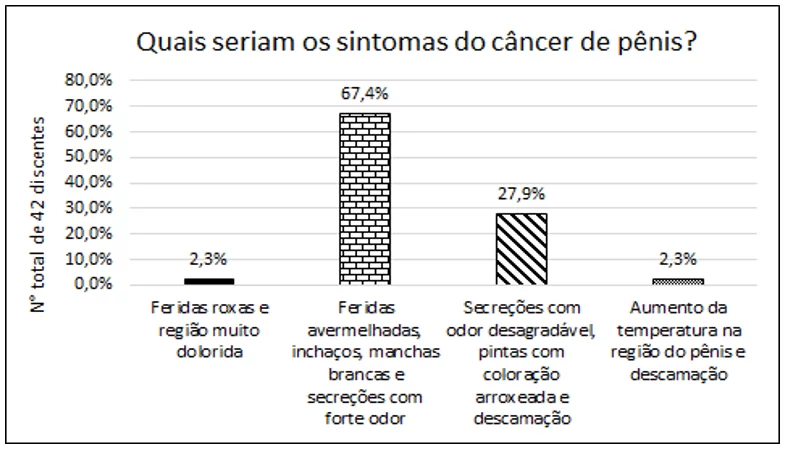
The most cited symptoms were reddish wounds, swelling, white spots and secretions with a strong odor, with 67.4%. This result reveals a brief knowledge of the subject, unlike a study carried out by Chaves et al. (2018), with men between 18 and 70 years old in Basic Health Units in the city of Caxias – MA, where 85.5% of men do not know the initial symptomatology of this disease.
With regard to the main risk factors for contracting penile cancer, 86% of the students interviewed mentioned sexual intercourse without using a condom, lack of information, accumulation of smegma and phimosis; 6.97% associated phimosis with lack of personal hygiene; and 23.2% indicated carelessness with annual exams and lack of information (Figure 2).
Figure 2. Data referring to students’ answers about what would be the main risk factors for contracting penile cancer. Results expressed in percentage
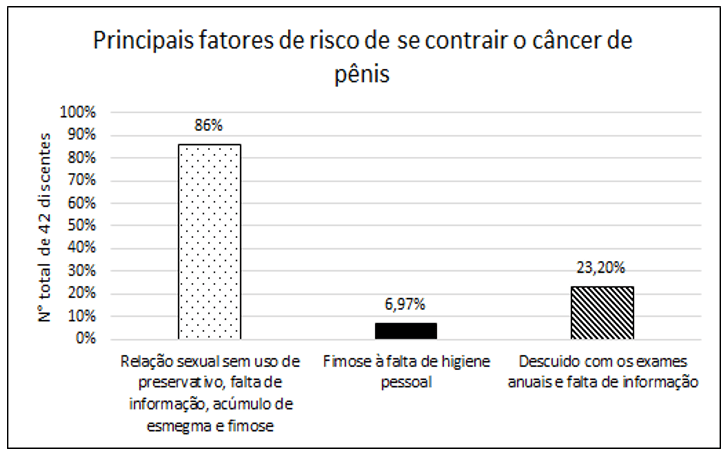
Most of the students associated unprotected sexual intercourse, lack of information, accumulation of smegma and phimosis as one of the main risk factors for the development of penile cancer, demonstrating that these students have a reasonable knowledge of the factors surrounding this neoplasm, since studies indicate an association of penile cancer with the HPV genome in 15 to 71% of cases.
In addition, in 85% of cases of precancerous lesions, there is a history of phimosis, usually associated with inadequate hygiene (OLIVEIRA et al., 2020). Although they demonstrate that they are aware of some of the main risk factors, it is worth highlighting the low incidence of responses regarding lack of personal hygiene and carelessness with annual exams. This fact is in line with studies that indicate that men have greater difficulty in adopting healthy behaviors and that they do not pose risks to their health, consequently, they seek the health service less than women (CARNEIRO; ADJUTO and ALVES, 2019).
Students were also asked if they think that HPV infection is related to penile cancer. 83.7% said yes and 9.3% said no (Figure 3).
Figure 3. Shows data referring to students’ responses on whether there is a relationship between HPV and penile cancer, expressed as a percentage
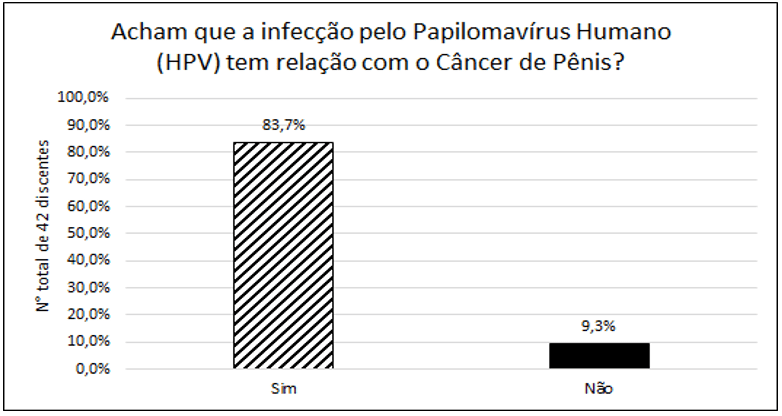
Although the smallest proportion of students is not aware of this correlation, this data demonstrates that the vast majority of students are aware of the virus and its aspects, since HPV is the most common sexually transmitted virus in the world, including Brazil. It is estimated that there are 9 to 10 million people infected by this virus and that, each year, 700,000 new cases occur (ABREU et al., 2018).
Man is the main link in the epidemiological chain, being the main carrier and vector of the virus. The male genital organ allows further development and multiplication of HPV. The practice of sexual relations without the use of condoms or other methods of prevention can lead to the development of lesions that, if not treated (either due to lack of knowledge or refusal to seek health services) can progress to cancer (LIMA ; LOPES and BATISTA, 2020).
At the end of the questionnaire, questions were asked about preventive measures against penile cancer, where 25.5% of respondents indicated the act of washing the penis with soap and water; 18.6% included performing phimosis surgery; and 48.8% sex with a condom (Figure 4).
Figure 4. Data referring to students’ answers about what preventive measures against penile cancer would be, expressed as a percentage
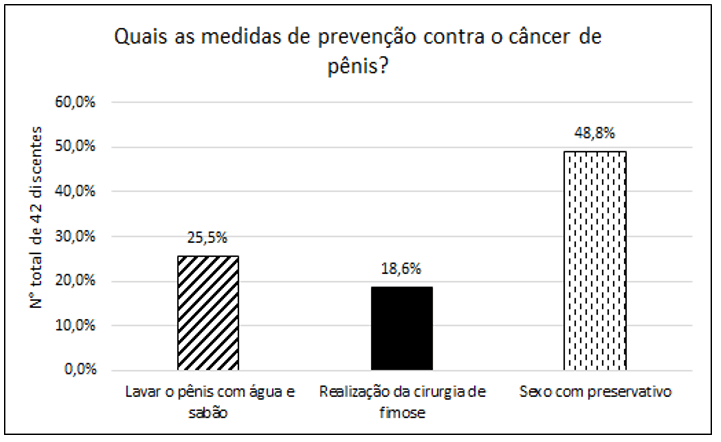
With these data, we can observe a small equity between the first two answers and a greater emphasis of the students on the use of condoms as a form of prevention against penile carcinoma, which reinforces the importance of practicing safe sex to avoid contamination by HPV. and by other agents that cause sexually transmitted diseases.
According to Costa et al. (2013), the decrease in the incidence of penile cancer can occur through the practice of circumcision in childhood, as well as through the practice of constant and adequate hygiene habits. This finding, when confronted with the data mentioned above, shows the lack of knowledge of the population sample studied about the most assertive preventive methods against penile cancer.
The analysis of the data collected in this study reinforces the certainty that it is extremely important to carry out campaigns to prevent penile cancer. The correct dissemination of the importance of using condoms to prevent the transmission of sexually transmitted viruses (such as those that cause AIDS and HPV) seems to induce a distortion in the population’s understanding of penile cancer prevention. Because both situations refer to the sexual sphere, measures to prevent sexually transmitted diseases are confused with those that should be applied to penile cancer. Thus, clarifications about the differential characteristics of these conditions are necessary for the subjects to understand the specific characteristics of penile cancer in its initial stages and, when seeking adequate health care, prevent the evolution to more advanced stages of the disease, reducing its severity and increasing the chances of cure or survival time (CORREIA et al., 2018).
The educational action for the prevention of this type of cancer, one of the basic health actions, must be a professional commitment with the quality of life of the population and with the quality of care, reiterating the autonomy of the patient in his self-care (BARROS and MELO, 2009).
Education, too, must be seen, not just as an additional activity that is developed in health services, but as an action that reorients the global practices of professionals in health units (SOUZA et al., 2011).
In addition to health services, schools can participate as agents disseminating information to increase the quality of life of children and adolescents (MACHADO et al., 2021). As a way of systematizing the school environment in the practice of health promotion, the Federal Government instituted the PSE[9] (School Health Program), which is an intersectoral Health and Education policy that, as the name already says, uses the school environment to, together with the health services, promote the development of children and adolescents in the public school system in an integral way. Thus, in addition to curricular pedagogical approaches, the school becomes an environment for carrying out preventive actions for various diseases and health promotion (BRASIL, 2022).
Suassuna et al. (2020), state that not all schools have education actions carried out by health professionals, highlighting failures of the PSE action on the public network of Natal/RN. This report encourages reflection that, in a country of continental proportions such as Brazil, programs such as the PSE may not reach everyone in need, further increasing the importance of carrying out school actions that aim to disseminate preventive information and dialogue with students, thus contributing to the State through the promotion of public health.
FINAL CONSIDERATIONS
Although students demonstrated knowledge about sex education, the high rates of penile cancer in developing countries, including Brazil, demonstrate the need to intensify campaigns on the specific topic. Schools, which are frequented by adolescents and also because they are places for disseminating knowledge, promoting debates and clarifying doubts, can act together with the State in the prevention of this disease, which, through the adoption of simple measures, can have its rates reduced considerably.
THANKS
The Universidade Federal Rural de Pernambuco, through the Pro-Rectory of Research and Graduate Studies and the Coordination of Special Programs/Institutional High School Scientific Initiation Scholarship Program for granting the Scholarship and to those who manage EREM Professor Cândido Duarte for trust and partnership established.
REFERENCES
ABREU, Mery Natali Silva; SOARES, Angela Deise; RAMOS, Diemack Alle Oliveira; SOARES, Fernanda Vieira; FILHO, Gerson Nunes; VALADÃO, Analina Furtado; MOTTA, Patrícia Gonçalves da. Conhecimento e percepção sobre o HPV na população com mais de 18 anos da cidade de Ipatinga, MG, Brasil. Ciência & Saúde Coletiva, v. 23, n. 3, p. 849-860, mar. 2018. Disponível em: DOI: 10.1590/1413-81232018233.00102016. Acesso em: 10 fev. 2023.
AKERS, Clare; HOLDEN, Fiona. An overview of the diagnoses and treatments for penile cancer. British Journal of Nursing, v. 29, n. 9, p. S6-S14, 14 maio 2020. Disponível em: DOI: 10.12968/bjon.2020.29.9.S6. Acesso em: 10 fev. 2023.
BARROS, Érika Neves de; MELO, Mônica Cristina Batista de. Câncer de pênis: perfil sócio-demográfico e respostas emocionais à penectomia em pacientes atendidos no Serviço de Psicologia do Hospital de Câncer de Pernambuco. Revista da SBPH, v. 12, n. 1, p. 99-111, 2009. Disponível em: http://pepsic.bvsalud.org/scielo.php?script=sci_arttext&pid=S1516-08582009000100008. Acesso em: 15 jun. 2022.
BRASIL. Lei nº 8.069, de 13 de julho de 1990. Dispõe sobre o Estatuto da Criança e do Adolescente e dá outras providências. Presidência da República, 1990. Disponível em: http://www.planalto.gov.br/ccivil_03/leis/l8069.htm. Acesso em: 10 fev. 2023.
BRASIL. Ministério Da Educação. Programa Saúde da Escola (PSE). Portal do Ministério da Educação, 2022. Disponível em: http://portal.mec.gov.br/programa-saude-da-escola/apresentacao. Acesso em: 20/06/2022.
BRASIL. Ministério Da Saúde. Caderneta de saúde do adolescente. 3ª edição 1ª reimpressão. Brasília – DF: Ministério da Saúde, 2014.
CARNEIRO, Viviane Santos Mendes; ADJUTO, Raphael Neiva Praça; ALVES, Kelly Aparecida Palma. Saúde do homem: identificação e análise dos fatores relacionados à procura, ou não, dos serviços de atenção primária. Arquivos de Ciências da Saúde da UNIPAR, v. 23, n. 1, 12 fev. 2019. Disponível em: DOI: https://doi.org/10.25110/arqsaude.v23i1.2019.6521. Acesso em: 10 fev. 2023.
CHAVES, Jairina Nunes; CÂMARA, Joseneide Teixeira; SILVA, Klécia de Sousa Marques da; PEDROSA, Aliny de Oliveira; SANTOS, Francisca Jéssica Lima dos. Conhecimento dos homens sobre o câncer de pênis. Revista Augustus, v. 22, n. 43, 12 abr. 2018. Disponível em: https://dx.doi.org/10.15202/782. Acesso em: 10 fev. 2023.
COLACITE, Jean; LOBATO, Carolina Colacite; LEAL, Juliana Ferreira; CARDOSO, Lediana Pereira; BORDIN, Joseane Ines Gresele; LIMA, Marciane Maria da Silva; LIMA, Fagner Mandu de; SOUZA, Layse Fernanda Antônio de. Fatores predisponentes do câncer de pênis: uma revisão de literatura. Brazilian Journal of Development, v. 7, n. 7, p. 70964-70973, 13 jul. 2021. Disponível em: DOI:10.34117/bjdv7n7-325. Acesso em: 10 fev. 2023.
CORREIA, Adriano Scalzer; SILVA, Gustavo Victor Furtado da; CHAGAS, Humberto Montoro; NASCIMENTO, Ítalo Marcelo do Rêgo; LESSA, Maria Helena Correia; COSTA JÚNIOR, Teodorico Romualdo. Câncer de Pênis: Resultados de uma Campanha de Prevenção. Revista Portal: Saúde e Sociedade, v. 3, n. 1, p. 628–638, 2018. Disponível em: DOI: https://doi.org/10.28998/rpss.v3i1.4143. Acesso em: 10 fev. 2023.
COSTA, Syvoney; RODRIGUES, Rosiane; BARBOSA, Laurivania; SILVA, Jailson; BRANDÃO, José Odinilson de Caldas; MEDEIROS, Caroline Sanuzi Quirino de. Câncer de pênis: epidemiologia e estratégias de prevenção. Caderno de Graduação – Ciências Biológicas e da Saúde – UNIT – Pernambuco, v. 1, n. 2, p. 23–33, 2013. Disponível em: https://periodicos.set.edu.br/facipesaude/article/view/1197. Acesso em: 10 jun. 2022.
CRUZ, Maria Nelice Marques; MATA, Nely Dayse Santos da; NEMER, Camila Rodrigues Barbosa; BRITO, Victor Hugo Oliveira; CALANDRINI, Tatiana do Socorro dos Santos. Vacina HPV: percepção de adolescentes atendidos em uma unidade básica de saúde do Amapá. Enfermagem em Foco, v. 10, n. 2, 2019. Disponível em: DOI: https://doi.org/10.21675/2357-707X.2019.v10.n2.2177. Acesso em: 10 fev. 2023.
COSTA, Ana Beatriz Barbosa da; MORAIS, Elton Santos Guedes de Morais de; SANTANA, Lucas Vinnicio de Araujo; SOARES, Anísio Francisco. Avaliação do conhecimento sobre o tema: sexualidade entre adolescentes de escolas públicas. Latin American Journal of Development, v. 4, n. 2, p. 420–432, 2022. Disponível em: DOI: https://doi.org/10.46814/lajdv4n2-012. Acesso em: 10 fev. 2023.
DOMINGOS, Luiz Fabio; SANTANA, Cláudio Manoel Luiz de; ZANATTA, Cleia. Adolescência e sexualidade. RECIMA21- Revista Científica Multidisciplinar, v. 2, n. 7, p. e27538, 2021. Disponível em: DOI: https://doi.org/10.47820/recima21.v2i7.538. Acesso em: 10 fev. 2023.
DURST, Matthias; GISSMANN, Lutz; IKENBERG, Hans; HAUSEN, Harald Zur. A papillomavirus DNA from a cervical carcinoma and its prevalence in cancer biopsy samples from different geographic regions. Proceedings of the National Academy of Sciences, v. 80, n. 12, p. 3812-3815, 1 jun. 1983. Disponível em: DOI: 10.1073/pnas.80.12.3812. Acesso em: 10 fev. 2023.
FIGLIUOLO, Giuseppe; LIMA, Samuel Nuno Pereira; COSTA, Sebastião Pinto da; SILVA, Jusimara Maia da; PAIVA, Cristiano Silveira; BEZERRA, Jose Nilson Araújo; SILVA, Kátia Luz Torres. Perfil clínico-epidemiológico associado a fatores de risco de pacientes com câncer de pênis atendidos em um Hospital de Referência Oncológica em Manaus. Revista Brasileira de Oncologia Clínica, v. 11, n. 40, 2015. Disponível em: https://www.sboc.org.br/sboc-site/revista-sboc/pdfs/40/artigo1.pdf. Acesso em: 10 fev. 2023.
GENZ, Niviane; MEINCKE, Sonia Maria Könzgen; CARRET, Maria Laura Vidal; CORRÊA, Ana Cândida Lopes; ALVES, Camila Neumaier. Sexually transmitted diseases: knowledge and sexual behavior of adolescents. Texto & Contexto-Enfermagem, v. 26, 2017. Disponível em: DOI: 10.1590/0104-07072017005100015. Acesso em: 10 fev. 2023.
GOMES, Romeu; NASCIMENTO, Elaine Ferreira do; ARAÚJO, Fábio Carvalho de. Por que os homens buscam menos os serviços de saúde do que as mulheres? As explicações de homens com baixa escolaridade e homens com ensino superior. Cadernos de Saúde Pública, v. 23, n. 3, p. 565-574, mar. 2007. Disponível em: https://doi.org/10.1590/S0102-311X2007000300015. Acesso em: 10 fev. 2023.
GRESSLER, Lori Alice. Introdução à pesquisa: projetos e relatórios. 2º Ed. São Paulo: Loyola, 2004. 295 p.
INSTITUTO NACIONAL DE CÂNCER – INCA. Atlas de Mortalidade por Câncer. Instituto Nacional de Câncer, 2022. Disponível em: https://www.inca.gov.br/aplicativos/atlas-de-mortalidade-por-cancer. Acesso em: 20 mai. 2022.
LEVORATO, Cleice Daiana; MELLO, Luane Marques de; SILVA, Anderson Soares da; NUNES, Altacílio Aparecido. Fatores associados à procura por serviços de saúde numa perspectiva relacional de gênero. Ciência & Saúde Coletiva, v. 19, n. 4, p. 1263-1274, abr. 2014. Disponível em: https://doi.org/10.1590/1413-81232014194.01242013. Acesso em: 10 fev. 2023.
LIMA, Emanuel Loureiro; LOPES, Karolynne Costa; BATISTA, Nelson Jorge Carvalho. Factors that influence the manifestation of HPV in men. Research, Society and Development, v. 9, n. 7, p. e722974817, 2020. Disponível em: DOI: https://doi.org/10.33448/rsd-v9i7.4817. Acesso em: 10 fev. 2023.
MACHADO, Flávia Christiane de Azevedo; MOURA, Adriely Fernanda da Silva; TEIXEIRA, Ylari Cabral; CAMPELO, Maria Carolina Dantas; ROCHA NETO, Agenor Medeiros da; OLIVEIRA, Kedma Valnice Freire; MEDEIROS, Ysla Kallena Macedo e. Educação em saúde para sensibilizar adolescentes escolares para a vacinação contra o papiloma vírus humanos. Revista Ciência Plural, v. 7, n. 2, p. 177–195, 2021. Disponível em: DOI: https://doi.org/10.21680/2446-7286.2021v7n2ID22015. Acesso em: 10 fev. 2023.
MCCANCE, Dennis J.; KALACHE, Alexandre; ASHDOWN, K.; ANDRADE, L.; MENEZES, F.; SMITH, P.; DOLL, R. Human papillomavirus types 16 and 18 in carcinomas of the penis from brazil. International Journal of Cancer, v. 37, n. 1, p. 55-59, 15 jan. 1986. Disponível em: https://doi.org/10.1002/ijc.2910370110. Acesso em: 25 mai. 2022.
MINAYO, Maria Cecília de Souza. O desafio do conhecimento: pesquisa qualitativa em saúde. 5º Ed. São Paulo: HUCITEC-ABRASCO. 1998. 269 p.
OLIVEIRA, Renato Tavares Vieira de; BERNARDES, Gabriela de Oliveira; ALMEIDA, Isabella Passos; RIBEIRO, Marcelo de Freitas; ALMEIDA, Nathália Moura de; MACHADO, Lara Cândida de Sousa. Prevenção do câncer de pênis e a valorização da saúde do homem. Brazilian journal of health review, v. 3, n. 2, p. 1527-1530, 2020. Disponível em: DOI: https://doi.org/10.34119/bjhrv3n2-016. Acesso em: 10 fev. 2023.
ORGANIZACIÓN MUNDIAL DE LA SALUD – OMS. Problemas de salud de la adolescencia: informe de un Comité de Expertos de la OMS. Genebra: Organización Mundial de la Salud, 1965. Disponível em: https://apps.who.int/iris/handle/10665/38485. Acesso em: 25 mai. 2022.
SANTANA, Magda Rebeca da Conceição; MENDONÇA, Diogo Falcão Pereira de; MORAIS, Elton Santos Guedes de; ARAUJO, Vinicius Breno Silva de; SOARES Anísio Francisco. Ação preventiva à gestação na adolescência entre estudantes de uma escola de referência do ensino médio, localizada no município de Paudalho/PE. Revista Científica Multidisciplinar Núcleo do Conhecimento, p. 22-39, 26 abr. 2022. Disponível em: DOI: 10.32749/nucleodoconhecimento.com.br/educacao/acao-preventiva. Acesso em: 25 mai. 2022.
SOUZA, Darlane Marinho de; FUJINAMI, Tatiana Issida; SARTORIO, Nadja Nara Dourado Rodrigues; LOPES, Priscila Toledo Vidal; SILVA, Danúbio Riberio da. Cuidado à Saúde do Homem na Atenção Primária à Saúde. In: Congresso internacional de qualidade em serviços e sistemas de saúde. Galoa, 2019. Disponível em: DOI: 10.17648/qualihosp-2019-112244. Acesso em: 10 fev. 2023.
SOUZA, Kelly Wanessa de; REIS, Paula Elaine Diniz dos; GOMES, Isabelle Pimentel; CARVALHO, Emília Campos de. Prevention strategies for testicular and penile cancer: an integrative review. Revista da Escola de Enfermagem da USP, v. 45, p. 277-282, 2011. Disponível em: DOI: https://doi.org/10.1590/S0080-62342011000100039. Acesso em: 10 fev. 2023.
STRATTON, Kelly L.; CULKIN, Daniel J. A Contemporary Review of HPV and Penile Cancer. Oncology (Williston Park), vol. 30, n. 3, p. 245-9, 2016. Disponível em: https://pubmed.ncbi.nlm.nih.gov/26984219/. Acesso em: 05 jun. 2022.
SUASSUNA, Alice Pinheiro; OLIVEIRA, Suelen Ferreira de; PAPA, Thomas Diniz; MACHADO, Flávia Christiane de Azevedo. Percepções de alunos da rede pública de ensino de Natal/RN sobre educação em saúde na escola. Revista Ciência Plural, v. 6, n. 2, p. 66–81, 2020. DOI: https://doi.org/10.21680/2446-7286.2020v6n2ID19841. Acesso em: 10 jun. 2022.
TEIXEIRA, Danilo Boa Sorte. Atenção à saúde do homem: análise da sua resistência na procura dos serviços de saúde. Revista Cubana de Enfermería, v. 32, n. 4, 2016. Disponível em: http://revenfermeria.sld.cu/index.php/enf/article/view/985. Acesso em: 10 jun. 2022.
VILLA, Luisa Lina; LOPES, Ademar. Human papillomavirus DNA sequences in penile carcinomas in Brazil. International Journal of Cancer, v. 37, n. 6, p. 853-855, 15 jun. 1986. Disponível em: DOI: 10.1002/ijc.2910370610. Acesso em: 25 mai. 2022.
WIND, Mariana Malagoni; FERNANDES, Luana Mendonça Siqueira; PINHEIRO, Déborah Helena Pereira; FERREIRA, Verônica Reis; GABRIEL, Ana Carolina Guterres; CORREIA, Sara Fernandes; SILVA, Constanza Thaise Xavier. Câncer de pênis: aspectos epidemiológicos, psicológicos e fatores de risco. Brazilian Journal of Development, v. 5, n. 9, p. 14613-14623, 2019. Disponível em: DOI: https://doi.org/10.34117/bjdv5n9-066. Acesso em: 25 mai. 2022.
APPENDIX – FOOTNOTE
5. Ministério da Saúde (MS).
6. Estatuto da Criança e do Adolescente (ECA).
7. Política Nacional de Atenção Integral à Saúde do Homem (PNAISH).
8. Termo de Consentimento Livre e Esclarecido (TCLE).
9. Programa Saúde na Escola (PSE).
[1] Student of the Degree in Biological Sciences. ORCID: 0000-0002-4909-5130. CURRICULUM LATTES: http://lattes.cnpq.br/7183090938126805.
[2] Student of the Degree in Biological Sciences. ORCID: 0000-0002-7538-4518. CURRICULUM LATTES: http://lattes.cnpq.br/7228937531370032.
[3] PhD in Animal Bioscience, Master in Anatomy, Dentistry. ORCID: 0000-0002-6809-8396. CURRICULUM LATTES: http://lattes.cnpq.br/5056572269695104.
[4] PhD in Biochemistry and Physiology, Master in Physiology, Biologist. ORCID: 0000-0003-1493-7964. CURRICULUM LATTES: http://lattes.cnpq.br/9044747136928972.
Sent: January, 2023.
Approved: February, 2023.















